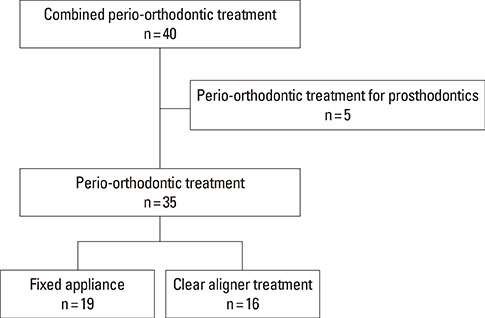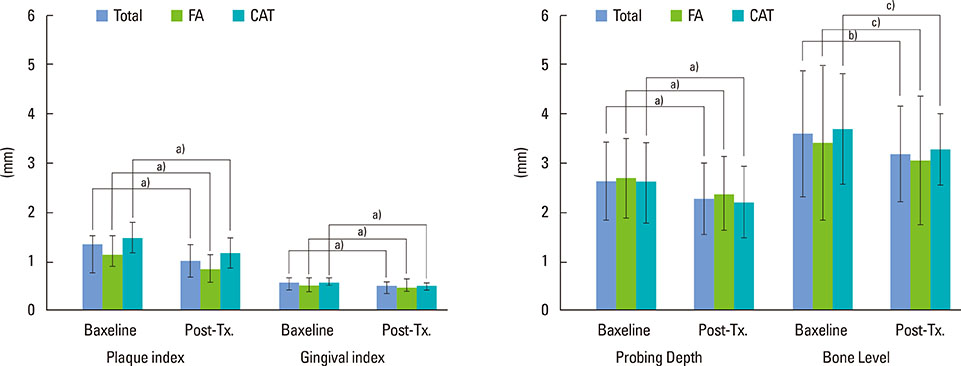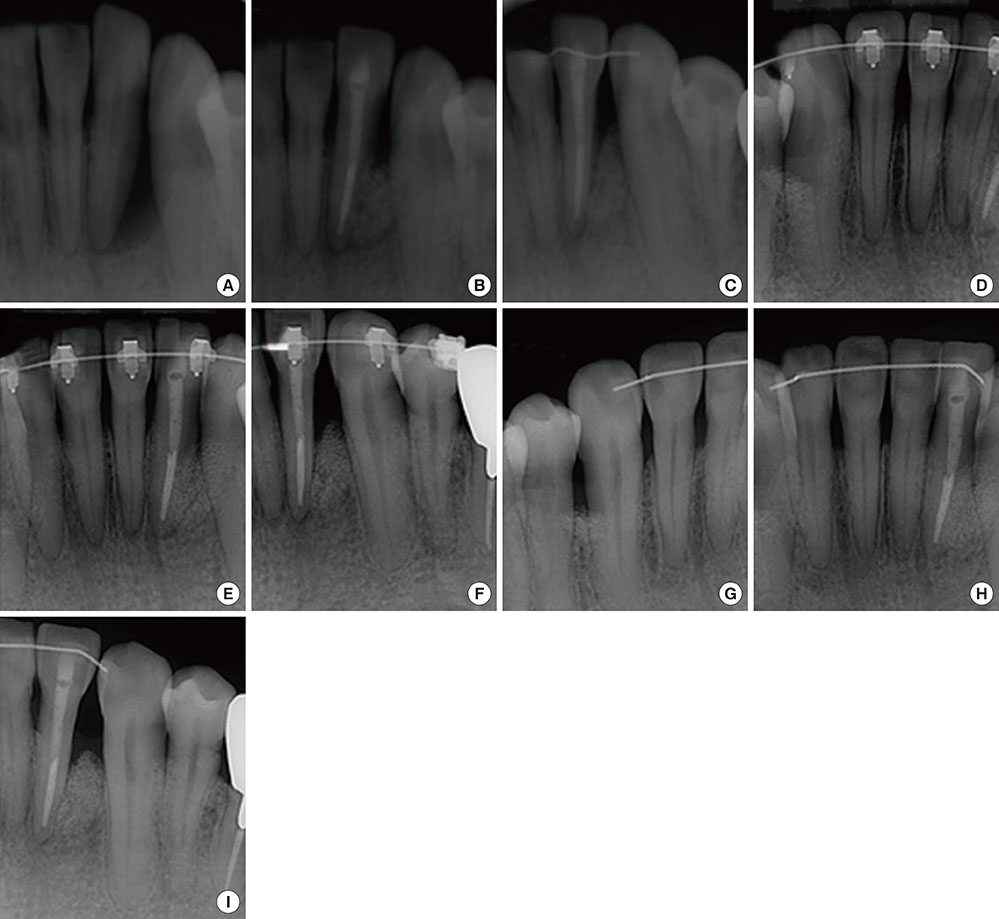J Periodontal Implant Sci.
2015 Dec;45(6):193-204. 10.5051/jpis.2015.45.6.193.
A comparative study of combined periodontal and orthodontic treatment with fixed appliances and clear aligners in patients with periodontitis
- Affiliations
-
- 1Department of Periodontology, Division of Dentistry, Hanyang University College of Medicine, Seoul, Korea.
- KMID: 2354936
- DOI: http://doi.org/10.5051/jpis.2015.45.6.193
Abstract
- PURPOSE
With the increasing prevalence of orthodontic treatment in adults, clear aligner treatments are becoming more popular. The aim of this study was to evaluate the effect of orthodontic treatment on periodontal tissue and to compare orthodontic treatment with fixed appliances (FA) to clear aligner treatment (CAT) in periodontitis patients.
METHODS
A total of 35 patients who underwent orthodontic treatment in the Department of Periodontology were included in this study. After periodontal treatment with meticulous oral hygiene education, patients underwent treatment with FA or CAT, and this study analyzed patient outcomes depending on the treatment strategy. Clinical parameters were assessed at baseline and after orthodontic treatment, and the duration of treatment was compared between these two groups.
RESULTS
The overall plaque index, the gingival index, and probing depth improved after orthodontic treatment (P<0.01). The overall bone level also improved (P=0.045). However, the bone level changes in the FA and CAT groups were not significantly different. Significant differences were found between the FA and CAT groups in probing depth, change in probing depth, and duration of treatment (P<0.05). However, no significant differences were found between the FA and CAT groups regarding the plaque index, changes in the plaque index, the gingival index, changes in the gingival index, or changes in the alveolar bone level. The percentage of females in the CAT group (88%) was significantly greater than in the FA group (37%) (P<0.01).
CONCLUSIONS
After orthodontic treatment, clinical parameters were improved in the FA and CAT groups with meticulous oral hygiene education and plaque control. Regarding plaque index and gingival index, no significant differences were found between these two groups. We suggest that combined periodontal and orthodontic treatment can improve patients' periodontal health irrespective of orthodontic techniques.
Keyword
MeSH Terms
Figure
Cited by 1 articles
-
Periodontal health status, oral microbiome, white-spot lesions and oral health related to quality of life-clear aligners versus fixed appliances: A systematic review, meta-analysis and meta-regression
Ana Sandra Llera-Romero, Milagros Adobes-Martín, José Enrique Iranzo-Cortés, José Maria Montiel-Company, Daniele Garcovich
Korean J Orthod. 2023;53(6):374-392. doi: 10.4041/kjod22.272.
Reference
-
1. Gkantidis N, Christou P, Topouzelis N. The orthodontic-periodontic interrelationship in integrated treatment challenges: a systematic review. J Oral Rehabil. 2010; 37:377–467.
Article2. Türkkahraman H, Sayin MO, Bozkurt FY, Yetkin Z, Kaya S, Onal S. Archwire ligation techniques, microbial colonization, and periodontal status in orthodontically treated patients. Angle Orthod. 2005; 75:231–237.3. Boyd RL, Leggott PJ, Quinn RS, Eakle WS, Chambers D. Periodontal implications of orthodontic treatment in adults with reduced or normal periodontal tissues versus those of adolescents. Am J Orthod Dentofacial Orthop. 1989; 96:191–199.
Article4. Chou YH, Du JK, Chou ST, Hu KF, Tsai CC, Ho KY, et al. An interdisciplinary treatment approach combining orthodontic forced eruption with immediate implant placement to achieve a satisfactory treatment outcome: a case report. Clin Implant Dent Relat Res. 2013; 15:113–133.
Article5. Liu XF, Pan XG, Shu R. A preliminary study of combined periodontal-orthodontic approach for treating labial displacement of incisors in patients with periodontal diseases. Shanghai Kou Qiang Yi Xue. 2008; 17:264–270.6. Artun J, Urbye KS. The effect of orthodontic treatment on periodontal bone support in patients with advanced loss of marginal periodontium. Am J Orthod Dentofacial Orthop. 1988; 93:143–151.
Article7. Nelson PA, Artun J. Alveolar bone loss of maxillary anterior teeth in adult orthodontic patients. Am J Orthod Dentofacial Orthop. 1997; 111:328–362.
Article8. Re S, Corrente G, Abundo R, Cardaropoli D. Orthodontic treatment in periodontally compromised patients: 12-year report. Int J Periodontics Restorative Dent. 2000; 20:31–40.9. Bollen AM, Cunha-Cruz J, Bakko DW, Huang GJ, Hujoel PP. The effects of orthodontic therapy on periodontal health: a systematic review of controlled evidence. J Am Dent Assoc. 2008; 139:413–435.10. Wennström JL, Stokland BL, Nyman S, Thilander B. Periodontal tissue response to orthodontic movement of teeth with infrabony pockets. Am J Orthod Dentofacial Orthop. 1993; 103:313–322.
Article11. Boas Nogueira AV, Chaves de Souza JA, Kim YJ, Damião de Sousa-Neto M, Chan Cirelli C, Cirelli JA. Orthodontic force increases interleukin-1β and tumor necrosis factor-α expression and alveolar bone loss in periodontitis. J Periodontol. 2013; 84:1319–1345.
Article12. van Gastel J, Quirynen M, Teughels W, Carels C. The relationships between malocclusion, fixed orthodontic appliances and periodontal disease. A review of the literature. Aust Orthod J. 2007; 23:121–130.13. Miethke RR, Vogt S. A comparison of the periodontal health of patients during treatment with the Invisalign system and with fixed orthodontic appliances. J Orofac Orthop. 2005; 66:219–248.
Article14. Miethke RR, Brauner K. A Comparison of the periodontal health of patients during treatment with the Invisalign system and with fixed lingual appliances. J Orofac Orthop. 2007; 68:223–254.
Article15. Boyd RL. Periodontal and restorative considerations with clear aligner treatment to establish a more favorable restorative environment. Compend Contin Educ Dent. 2009; 30:280–282. –284. –6-8 passim.16. Pavoni C, Lione R, Laganà G, Cozza P. Self-ligating versus Invisalign: analysis of dento-alveolar effects. Ann Stomatol (Roma). 2011; 2:23–30.17. Drake CT, McGorray SP, Dolce C, Nair M, Wheeler TT. Orthodontic tooth movement with clear aligners. ISRN Dent. 2012; 2012:657973.
Article18. Kravitz ND, Kusnoto B, Agran B, Viana G. Influence of attachments and interproximal reduction on the accuracy of canine rotation with Invisalign. A prospective clinical study. Angle Orthod. 2008; 78:682–689.19. Savage A, Eaton KA, Moles DR, Needleman I. A systematic review of definitions of periodontitis and methods that have been used to identify this disease. J Clin Periodontol. 2009; 36:458–525.
Article20. Silness J, Loe H. Periodontal Disease in Pregnancy. Ii. Correlation between Oral Hygiene and Periodontal Condtion. Acta Odontol Scand. 1964; 22:121–156.21. Loe H, Silness J. Periodontal Disease in Pregnancy. I. Prevalence and Severity. Acta Odontol Scand. 1963; 21:533–584.
Article22. Kim TS, Obst C, Zehaczek S, Geenen C. Detection of bone loss with different X-ray techniques in periodontal patients. J Periodontol. 2008; 79:1141–1150.
Article23. Proffit WR, Fields HW. Contemporary orthodontics. 2nd ed. St. Louis: Mosby;1992. p. 554–606.24. Stanaitytė R, Trakinienė G, Gervickas A. Do wisdom teeth induce lower anterior teeth crowding? A systematic literature review. Stomatologija. 2014; 16:15–23.25. Bishara SE, Treder JE, Damon P, Olsen M. Changes in the dental arches and dentition between 25 and 45 years of age. Angle Orthod. 1996; 66:417–439.26. Krishnan V, Davidovitch Z. Cellular, molecular, and tissue-level reactions to orthodontic force. Am J Orthod Dentofacial Orthop. 2006; 129:469.e1–4722.
Article27. Davidovitch Z, Nicolay OF, Ngan PW, Shanfeld JL. Neurotransmitters, cytokines, and the control of alveolar bone remodeling in orthodontics. Dent Clin North Am. 1988; 32:411–446.28. Bonafe-Oliveira L, Faltin RM, Arana-Chavez VE. Ultrastructural and histochemical examination of alveolar bone at the pressure areas of rat molars submitted to continuous orthodontic force. Eur J Oral Sci. 2003; 111:410–416.
Article29. Rossini G, Parrini S, Castroflorio T, Deregibus A, Debernardi CL. Efficacy of clear aligners in controlling orthodontic tooth movement: a systematic review. Angle Orthod. 2015; 85:881–890.
Article30. Cattaneo PM, Dalstra M, Melsen B. Strains in periodontal ligament and alveolar bone associated with orthodontic tooth movement analyzed by finite element. Orthod Craniofac Res. 2009; 12:120–128.
Article31. Nakao K, Goto T, Gunjigake KK, Konoo T, Kobayashi S, Yamaguchi K. Intermittent force induces high RANKL expression in human periodontal ligament cells. J Dent Res. 2007; 86:623–631.
Article32. Diedrich PR. Guided tissue regeneration associated with orthodontic therapy. Semin Orthod. 1996; 2:39–45.
Article33. Cardaropoli D, Re S, Manuzzi W, Gaveglio L, Cardaropoli G. Bio-Oss collagen and orthodontic movement for the treatment of infrabony defects in the esthetic zone. Int J Periodontics Restorative Dent. 2006; 26:553–562.34. Ogihara S, Marks MH. Enhancing the regenerative potential of guided tissue regeneration to treat an intrabony defect and adjacent ridge deformity by orthodontic extrusive force. J Periodontol. 2006; 77:2093–2193.
Article35. Passanezi E, Janson M, Janson G, Sant’Anna AP, de Freitas MR, Henriques JF. Interdisciplinary treatment of localized juvenile periodontitis: a new perspective to an old problem. Am J Orthod Dentofacial Orthop. 2007; 131:268–344.
Article36. Rossini G, Parrini S, Castroflorio T, Deregibus A, Debernardi CL. Periodontal health during clear aligners treatment: a systematic review. Eur J Orthod. 2015; 37:539–582.
Article37. Araújo MG, Carmagnola D, Berglundh T, Thilander B, Lindhe J. Orthodontic movement in bone defects augmented with Bio-Oss. An experimental study in dogs. J Clin Periodontol. 2001; 28:73–80.
Article38. Ahn HW, Ohe JY, Lee SH, Park YG, Kim SJ. Timing of force application affects the rate of tooth movement into surgical alveolar defects with grafts in beagles. Am J Orthod Dentofacial Orthop. 2014; 145:486–581.
Article39. Roberts WE, Chase DC. Kinetics of cell proliferation and migration associated with orthodontically-induced osteogenesis. J Dent Res. 1981; 60:174–255.
Article40. Melsen B, Agerbaek N, Eriksen J, Terp S. New attachment through periodontal treatment and orthodontic intrusion. Am J Orthod Dentofacial Orthop. 1988; 94:104–120.
Article
- Full Text Links
- Actions
-
Cited
- CITED
-
- Close
- Share
- Similar articles
-
- Orthodontic treatment with clear aligners for a patient with chronic periodontitis
- Clinical factors affecting the longevity of fixed retainers and the influence of fixed retainers on periodontal health in periodontitis patients: a retrospective study
- Pain perception among patients treated with passive self-ligating fixed appliances and Invisalign® aligners during the first week of orthodontic treatment
- The combined use of computer-guided, minimally invasive, flapless corticotomy and clear aligners as a novel approach to moderate crowding: A case report
- Initial changes of dental plaque, gingivitis and decalcification in Korean orthodontic patients with fixed appliance










